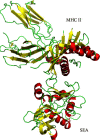Blocking Superantigen-Mediated Diseases: Challenges and Future Trends
- PMID: 38268531
- PMCID: PMC10807946
- DOI: 10.1155/2024/2313062
Blocking Superantigen-Mediated Diseases: Challenges and Future Trends
Abstract
Superantigens are virulence factors secreted by microorganisms that can cause various immune diseases, such as overactivating the immune system, resulting in cytokine storms, rheumatoid arthritis, and multiple sclerosis. Some studies have demonstrated that superantigens do not require intracellular processing and instated bind as intact proteins to the antigen-binding groove of major histocompatibility complex II on antigen-presenting cells, resulting in the activation of T cells with different T-cell receptor Vβ and subsequent overstimulation. To combat superantigen-mediated diseases, researchers have employed different approaches, such as antibodies and simulated peptides. However, due to the complex nature of superantigens, these approaches have not been entirely successful in achieving optimal therapeutic outcomes. CD28 interacts with members of the B7 molecule family to activate T cells. Its mimicking peptide has been suggested as a potential candidate to block superantigens, but it can lead to reduced T-cell activity while increasing the host's infection risk. Thus, this review focuses on the use of drug delivery methods to accurately target and block superantigens, while reducing the adverse effects associated with CD28 mimic peptides. We believe that this method has the potential to provide an effective and safe therapeutic strategy for superantigen-mediated diseases.
Copyright © 2024 Pengbo Wang et al.
Conflict of interest statement
The authors declare that they have no conflicts of interest.
Figures





Similar articles
-
Binding of superantigen toxins into the CD28 homodimer interface is essential for induction of cytokine genes that mediate lethal shock.PLoS Biol. 2011 Sep;9(9):e1001149. doi: 10.1371/journal.pbio.1001149. Epub 2011 Sep 13. PLoS Biol. 2011. PMID: 21931534 Free PMC article.
-
Superantigens hyperinduce inflammatory cytokines by enhancing the B7-2/CD28 costimulatory receptor interaction.Proc Natl Acad Sci U S A. 2016 Oct 18;113(42):E6437-E6446. doi: 10.1073/pnas.1603321113. Epub 2016 Oct 5. Proc Natl Acad Sci U S A. 2016. PMID: 27708164 Free PMC article.
-
Staphylococcal and Streptococcal Superantigens Trigger B7/CD28 Costimulatory Receptor Engagement to Hyperinduce Inflammatory Cytokines.Front Immunol. 2019 Apr 30;10:942. doi: 10.3389/fimmu.2019.00942. eCollection 2019. Front Immunol. 2019. PMID: 31114583 Free PMC article.
-
CD28: direct and critical receptor for superantigen toxins.Toxins (Basel). 2013 Sep 9;5(9):1531-42. doi: 10.3390/toxins5091531. Toxins (Basel). 2013. PMID: 24022021 Free PMC article. Review.
-
Bacterial Superantigen Toxins, CD28, and Drug Development.Toxins (Basel). 2018 Nov 6;10(11):459. doi: 10.3390/toxins10110459. Toxins (Basel). 2018. PMID: 30404186 Free PMC article. Review.
References
-
- Giantonio B. J., Alpaugh R. K., Schultz J., et al. Superantigen-based immunotherapy: a phase I trial of PNU-214565, a monoclonal antibody-staphylococcal enterotoxin a recombinant fusion protein, in advanced pancreatic and colorectal cancer. Journal of Clinical Oncology . 1997;15(5):1994–2007. doi: 10.1200/JCO.1997.15.5.1994. - DOI - PubMed
-
- Alpaugh R. K., Schultz J., McAleer C., et al. Superantigen-targeted therapy: phase I escalating repeat dose trial of the fusion protein PNU-214565 in patients with advanced gastrointestinal malignancies. Clinical Cancer Research . 1998;4:1903–1914. - PubMed
Publication types
MeSH terms
Substances
LinkOut - more resources
Full Text Sources

